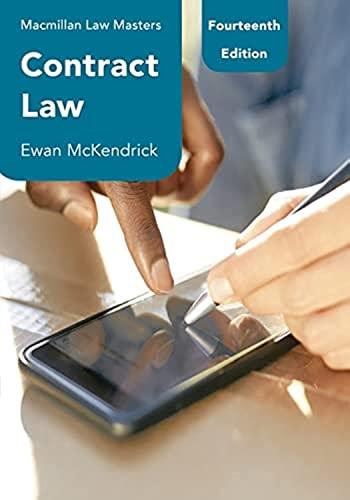Question
The Case Brief assignment requires students read the In re Winship case 397 US 358- Supreme Court 1970. These decisions were landmarks and ultimately led
The Case Brief assignment requires students read the In re Winship case 397 US 358- Supreme Court 1970. These decisions were landmarks and ultimately led to changes in our case law. These assignments allow you to work through the case from the perspective of one of the 9 justices and form your own opinion. Instructions: Using the case brief template, o Brief the In re Winship case 397 US 358 - Supreme Court 1970. A link to the case has been provided in the readings and resources section of the unit. o In the 7th step "analysis section" take the perspective of one the nine justices and explain what your decision would have been. Requirements: Submit the completed Case Brief Template. At least two resources.
The Title and Citation
The name of the person who initiated legal action.
Citation tells you how to locate the case.
The Facts
A one-sentence description of the nature of the case, to serve as an introduction.
A statement of the relevant law, with quotation marks or underlining to draw attention to the key words or phrases that are in dispute.
A summary of the complaint (in a civil case) or the indictment (in a criminal case) plus relevant evidence and arguments presented in court to explain who did what to whom and why the case was thought to involve illegal conduct.
A summary of actions taken by the lower courts, for example: defendant convicted; conviction upheld by appellate court; Supreme Court granted certiorari.
The Issue
When noting issues, it may help to phrase them in terms of questions that can be answered with a precise "yes" or "no."
What specific legal questions does this case raise?
What more general legal questions does this case raise?
2021 Post University, Waterbury, CT ALL RIGHTS RESERVED
2021 Post University, Waterbury, CT ALL RIGHTS RESERVED
The Decisions or Holding
How did the court answer the issue question(s)? YES or NO
Court's Reasoning
The reasoning, or rationale, is the chain of argument which led the judges in either a majority or a dissenting opinion to rule as they did. This should be outlined point by point in numbered sentences or paragraphs.
What legal reasoning informed the court's decision?
What rules of law, for example, did it apply?
How did it interpret legal principles, documents?
How did it construe the facts?
Separate Opinions
Both concurring and dissenting opinions should be subjected to the same depth of analysis to bring out the major points of agreement or disagreement with the majority opinion. Make a note of how each justice voted and how they lined up.
Analysis
Here the student should evaluate the significance of the case, its relationship to other cases, its place in history, and what is shows about the Court, its members, its decision-making processes, or the impact it has on litigants, government, or society. It is here that the implicit assumptions and values of the Justices should be probed, the "rightness" of the decision debated, and the logic of the reasoning considered. Also consider what existing legal questions, if any, are left unresolved by this case, and what new questions, if any, it raises.
Step by Step Solution
There are 3 Steps involved in it
Step: 1

Get Instant Access to Expert-Tailored Solutions
See step-by-step solutions with expert insights and AI powered tools for academic success
Step: 2

Step: 3

Ace Your Homework with AI
Get the answers you need in no time with our AI-driven, step-by-step assistance
Get Started


